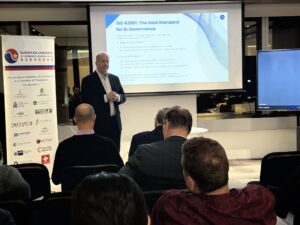The potential of Artificial Intelligence is irresistible: improved efficiency, richer insights, and revolutionary automation. But as firms eagerly embrace AI, one essential question towers above the rest: how do we ensure these powerful machines work ethically, responsibly, and, most importantly, in compliance? The solution is solid AI governance.
For companies, especially those in highly regulated sectors, effective AI governance is not merely about checking boxes; it’s about protecting reputation, defending customer trust, alleviating serious financial and legal exposure, and enabling innovation within secure parameters.
Nonetheless, let’s be pragmatic here: full-fledged AI governance is a challenging exercise. It entails walking through changing legislations, overcoming ethical issues, and building a new organizational culture. In this blog, we are going to delve into the best practices for rolling out AI governance in compliance and discuss the typical difficulties organizations encounter.
What is AI Governance in Compliance?
At its core, AI governance in compliance is about establishing a structured system of policies, processes, ethical principles, and oversight mechanisms to ensure that AI systems are developed, deployed, and monitored in a way that adheres to internal standards, legal requirements (like GDPR, HIPAA, EU AI Act), and societal values. It’s about proactive risk management and continuous assurance that your AI is operating as intended, without unintended biases, privacy breaches, or security vulnerabilities.
Best Practices for Implementing AI Governance
Effective AI governance needs to be implemented by adopting a strategy-driven, multi-perspective strategy. Below are some essential best practices:
- Set Definite Goals & Principles: Prior to exploring tools, determine what you aim to do with AI governance. Is it mostly regulatory compliance? Bias reduction? Increasing transparency? Your goals should be in line with your business values and strategic objectives. Define a solid base of ethical AI principles (e.g., fairness, accountability, transparency, privacy, human oversight) that will inform all AI projects.
- Conduct Comprehensive AI Risk Assessments: Not every AI system is equivalent in risk. Categorize your AI applications according to their potential consequences (e.g., low, medium, high risk, according to the EU AI Act). For every system, outline and evaluate potential risks against:
- Data: Bias in training data, data quality issues, privacy concerns.
- Model: Lack of explainability, performance drift, vulnerability to adversarial attacks.
- Outcome: Discriminatory results, unintended consequences, safety implications.
- Operational: Lack of human oversight, inadequate monitoring.
- Implement Strong Data Governance for AI: “Garbage in, garbage out” has never been more relevant. High-quality, unbiased, and secure data is the bedrock of trustworthy AI.
- Data Quality Controls: Implement rigorous processes for data validation, cleansing, and standardization.
- Data Provenance & Lineage: Track the origin and transformation of data used in AI models for full transparency and auditability.
- Privacy-Enhancing Technologies (PETs): Utilize techniques like anonymization, differential privacy, and federated learning to protect sensitive data.
- Prioritize Transparency and Explainability (XAI): For high-risk AI, understanding why a model made a particular decision is crucial for accountability and trust.
- Document Model Development: Keep detailed records of model architecture, training data, evaluation metrics, and design choices.
- Employ Explainable AI (XAI) Techniques: Use tools and methodologies (e.g., SHAP, LIME) to generate insights into model behavior, even for complex “black-box” models.
- Communicate Clearly: Ensure that explanations are understandable to relevant stakeholders, from data scientists to legal teams and even affected individuals.
- Define Clear Roles, Responsibilities, and Accountability: AI governance is a collective effort. Establish an interdisciplinary AI ethics or governance committee, comprising legal, compliance, data science, IT, and business unit representatives. Clearly define who is accountable for:
- AI development and deployment.
- Data quality and privacy.
- Monitoring AI performance and identifying bias.
- Responding to incidents or ethical concerns.
- Foster a Culture of Responsible AI: Policies on paper aren’t enough. Embed AI ethics and compliance into your organizational culture.
- Training & Education: Provide role-based training for all relevant staff on AI ethics, responsible AI principles, data handling, and specific regulatory requirements.
- Internal Guidelines: Develop a clear AI Code of Conduct that reflects your organization’s commitment to ethical and compliant AI.
- Incentivize Responsible Practices: Integrate AI governance into performance reviews and reward systems.
- Implement Continuous Monitoring and Auditing: AI models are not static; they can “drift” over time.
- Real-time Monitoring: Continuously track AI system performance, bias indicators, and adherence to policies.
- Regular Audits: Conduct periodic internal and external audits to verify compliance with frameworks like ISO 42001 and regulatory requirements.
- Feedback Loops: Establish mechanisms for users and affected parties to provide feedback on AI outputs, allowing for continuous improvement.
Challenges in Implementing AI Governance
While the benefits are clear, implementing AI governance is fraught with challenges:
- Rapidly Evolving Regulations: The regulatory landscape is a moving target. Laws like the EU AI Act are groundbreaking, but many jurisdictions are still crafting their approaches. Keeping pace requires constant vigilance and adaptability.
- Complexity of AI Systems: Modern AI, especially deep learning models, can be incredibly complex (“black box” problem), making it difficult to achieve full transparency and explainability, which are often compliance requirements.
- Data Quality & Bias Mitigation: Ensuring that training data is representative, accurate, and free from historical biases is a monumental task. Identifying and mitigating subtle biases within complex algorithms is even harder.
- Skill Gaps & Talent Shortage: There’s a shortage of professionals who deeply understand both AI technicalities and the nuances of legal and ethical compliance. Bridging this gap requires significant investment in training or external expertise.
- Siloed Operations & Lack of Collaboration: AI development often happens in technical silos, while compliance and legal teams work separately. Effective AI governance demands cross-functional collaboration, which can be challenging to achieve in large organizations.
- Resource Constraints: Implementing a robust AI governance framework requires significant investment in technology, personnel, and time. Smaller organizations, in particular, may struggle with these resource demands.
- Balancing Innovation with Control: Overly restrictive governance can stifle innovation, while too little oversight introduces unacceptable risks. Striking the right balance is a delicate art.
- Lack of Leadership Buy-in: If senior leadership doesn’t fully grasp the strategic importance of AI governance, it can be difficult to secure the necessary resources and organizational commitment.
How ComplyNexus Addresses These Challenges
This is where an intelligent, purpose-built platform like ComplyNexus becomes invaluable. We understand that effective AI governance isn’t about adding more manual work; it’s about intelligent automation and centralization.
Our AI Governance Platform is designed to address these very challenges head-on:
- Navigating Regulatory Complexity: Built to support emerging standards like ISO 42001, NIST AI RMF, and the EU AI Act, ComplyNexus provides structured guidance, ensuring you’re always aligned with the latest requirements.
- Automated Evidence Collection: Say goodbye to manual audit prep. Our AI-powered technology automates the collection, tracking, and validation of compliance data, giving you real-time insights and continuous audit readiness, even for complex AI models.
- Centralized Documentation & Risk Management: ComplyNexus brings all your AI governance documentation, risk assessments, and policies under one roof, eliminating fragmented systems and ensuring a single source of truth.
- Complytraining Hub: Our role-based training ensures your team is informed and compliant, addressing skill gaps and fostering a responsible AI culture throughout your organization.
- Flexible Integration: Whether you need a secure cloud-based SaaS solution, an in-house integration, or even an air-gapped AI agent like NEXUS Fortis for ultimate data control in highly sensitive environments, ComplyNexus offers the flexibility to fit your specific operational and security needs.
Conclusion: Your Compass for the AI Frontier
The journey of implementing AI governance in compliance is complex, but it’s a journey every organization leveraging AI must undertake. By embracing best practices and leveraging sophisticated platforms like ComplyNexus, you can transform these challenges into opportunities.
Investing in AI governance isn’t just about avoiding penalties; it’s about building enduring trust with your customers, fostering ethical innovation, and securing your place as a responsible leader in the AI-driven future. Don’t just deploy AI; govern it with precision, foresight, and the right tools.
Ready to simplify your AI governance and ensure flawless compliance?
Request a Free Demo of ComplyNexus Today!
 Skip to content
Skip to content





https://shorturl.fm/dKMZs
https://shorturl.fm/j4Nh6
https://shorturl.fm/scIkS
https://shorturl.fm/omQ07
https://shorturl.fm/p6Rpx
https://shorturl.fm/TtCea
https://shorturl.fm/p8aB8
https://shorturl.fm/remvL
https://shorturl.fm/ToNYz
https://shorturl.fm/JiyFc